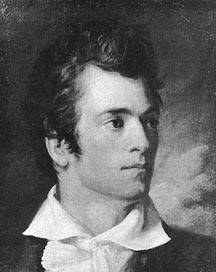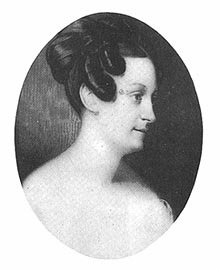

George Catlin
Written and researched by Margaret Odrowaz-Sypniewska, B.F.A.

GEORGE CATLIN, FRONTIER ARTIST:
George Catlin was born on July 26, 1796, in Wilkes-Barre, Pennsylvania. His father was Putnam Catlin. George Washington was still in his second term as president, at this time. George was the fifth child of fourteen children:
Putnam Catlin was born in Litchfield, Connecticut, on April 5, 1764. Putnam Catlin (1733-1820) was thought to be the son of Eli Catlin and Elizabeth Way(?). When George was 10 years old his interest in Indians would leave him scared for life. He and his friend were hurling a tomahawk at a tree when the hawk fell and cut Catlin's left cheek. This was a painful accident, but it did not stop his fascination with Native Americans. His father, Putnam, had enlisted in the Army during the Revolutionary War, at age thirteen (1777). He was first a regimental fife-major. This position he held for eight years. After the war, Putnam returned to Litchfield to study law. Then he moved to Wilkes-Barre, Pennsylvania, in 1789 (age 25) to begin his practice. Putnam Catlin married Mary "Polly" Sutton in 1789. Polly was born on September 30, 1770. Her parents were early settlers in Pennsylvania's Wyoming Valley. Polly and her mother were both captured by Indians. His maternal grandfather and his mother had been among the few survivors of Pennsylvania's "Wyoming Valley Massacre." This left an imprint on the family's history. George had heard many tales about the family's encounters with the Native American Indians. After this incident, Squire Putnam Catlin then moved to a farm in the forest on the banks of the Susquehanna River. Putnam Catlin died on March 12, 1842, in Great Bend, Susquehanna County, Pennsylvania.
Eli Catlin was a 1st Lieutenant in the 7th Connecticut regiment from July 6th - December 6th, 1775; 1st Lieutenant in the 19th Continental Infantry from January 1st - December 31, 1776; Captain of the 5th Connecticut regiment from January 1, 1777, until when he signed on May 25, 1778 (DAR records).
Polly Sutton Catlin, wife of Putnam Catlin, died on July 25, 1844, in Delta, Oneida County, New York. Polly is buried in the Old Delta Cemetary.
In 1824, George Catlin was a member of the Pennsylvania Academy of Fine Arts. In 1827, George moved to New York and was a member of the National Academy of Design there. While in New York, Catlin was commission to paint a full-length potrait of Governor Dewitt Clinton, which still hangs in the New York City Hall.
Putnam's son would make his mark in the world in a much different way. George Catlin was 5 feet, 8 inches tall and weighed only 135 pounds. He had blue eyes, dark complexion, and black hair. As he got older and his face more weathered he almost could pass for a Native American Indian. George entered law school in 1817, at age 21, at his parent's urging, even though his heart was not into that profession. He ended up working for the law office of Reeves and Gould in Litchfield, Connecticut. He then moved to Philadelphia, PA.
Many of George's relatives also lived in Connecticut. Grove Catlin (his cousin) had a tavern in Litchfield Green, and Grove had a daughter named Flora. Dr. Abel Catlin (his cousin) had an adopted daughter named Mary Peck. Some of his relatives dabbled in painting. "Another and stronger passion was getting the advantage of me, that of painting..." George began to have an interest in portrait painting, and his law office was cluttered with paints and bruushes, which over shadowed his law duties. Later he would work for many well-known personages of his time. In 1820, at age 24, George decided to sell his law library to try his hand at being an artist. His father wanted him to follow in his footsteps, but did NOT interfere with George's dream, especially when he described his great interest in the customs and people of the American Indian. The family was naturally worried for his safety.

He met Clara Bartlett, who seemingly shared his passion and supposed his decision to follow his dreams, even though it meant they would be apart for most of their married life. On May 28, 1828, George married Clarissa "Clara" Bartlett Gregory of Albany, New York. They were married by Reverend Lacy in Albany, New York. Clara was the daughter of Benjamin Gregory and Abigail Starr. Their marriage was not going to be an easy one. In 1830, both George and Clara became very sick. George recovered but still was weak, and Clara had to be taken to her father's home to be cared for while George continued to try to make his mark as an artist.
Catlin was a self-taught artist who started painting portraits of political figures. Inspired by an Indian delegation passing through Pennsylvania in 1824, he decided that Indians and their culture would be his primary subject matter. In 1830, George Catlin moved to St. Louis, Missouri, to begin his dream of chronicling the Native American Indian, and became friends with General William Clark by 1831. Catlin sketched and painted Indians who visited Clark at his office. Catlin was in Nebraska twice; once in 1831 and again in 1832. In 1831, Catlin ventured with Major Jean Dougherty on a trip up the Platte River. While on this trip Catlin made numerous sketches of the Indians in the area.
George and Clara first extended parting came in 1832 when Catlin boarded a steamboat in St. Louis and headed up the Missouri River to Fort Union. From here George would sail to the end of the line with his art supplies in hand, and continue by canoe or foot into the wilderness to sketch places he had missed. Catlin made a series of expeditions west of the Mississippi between 1832 and 1839. He visited the Arapahoe, Blackfeet, Cherokee, Cheyenne, Chickasaw,Chippewa, Choctaw, Comanche, Creek, Crow, Grand Pawbness, Ioway, Kiowa, Mandan, Menominee, Minataree, Missouri, Osage, Ottawa, Ponca, Sioux, Wichita, and others.
Only five years after Catlin visited the Mandan, their way of life was lost to hitory for all time. When George first visited the Mandans there were about 2,000 people on the upper Mississippi River. He said they were a happy people of good cheer. George Catlin was allow to see most of their lifestyle including the burial grounds. In his books he decribed the tribe's hallowed circle of skulls where family members would come daily to pay homage. In 1839, upon receiving word of the epidemic that sweep through the Mandan village, he grieved for the loss. It was said that smallpox spread with the arrival of traders and that the disease wiped them out in two (2) short months. Catlin was especially fond of their chief Mah-to-toh-pa or Four Bears. He described him as high-minded and gallant, and as polite as any polished gentleman.
The Sioux he wrote have the finest personal appearance. They were described as tall and straight and graceful in movement. At least one-half of the warriors were reported to have been "six feet or more in height." The Sioux were suspicious at first especially of having their likeness painted, but soon the social barriers were down and Catlin even witnessed a Bear Dance.
The paintings from this trip he presented to Congress in 1838, only to have them rejected. Catlin was largely unappreciated during his lifetime. He took his works to Europe where they were much more admired. One year before this, his "Indian Gallery" exhibit opened at New York's Clinton Hall on September 25, 1837. Admission was fifty (50) cents. By November 1, 1837, Catlin's gallery was in Stuyvesant Hall and admission was $1.00.
He traveled all over the United States to paint portraits of Native American Indians. This vocation was to be his lifelong passion. Most of Catlin's paintings are available from the National Portrait Gallery Museum collection, in Washington, D.C. He is now known as the foremost painter of the Native American Indian. His paintings are in some cases the only record of some of the chiefs and famous leaders of the various Indian nations.
George often times lived in a harsh environment which did not help his health. Clara and George had one son and three daughters. Clara Catlin died in Paris, France on July 28, 1845 (of pneumonia), when their family was visiting King Louis Philippe. She was buried in the Gregory family plot in Brooklyn, New York. Dudley S. Gregory was his brother-in-law. Dudley was married to one of George's sisters. George Catlin junior died at age four of typhoid fever. He is buried in Greenwood Cemetary next to his mother.
George Catlin then made three trips to South America in the 1850's. After coming home, he returned to New York and opened one more time in New York, on October 24, 1870, at the Sommerville Galley on Fifth Avenue and 14th Street. This show closed in November as interest in his work was dying. By this time, George Catlin was suffering from Bright's disease, which was said to be very painful. The family took hom from his cot in the Museum to Jersey City, where his brother-in-law. Dudley S. Gregory gave George a place to rest, since he was basically penniless from his travels and lack of profits from his showings. His daughters cared for him there.
George Catlin died on December 23, 1872 (at age 76) of Bright's disease. Bright's disease is a vague and obsolete term for disease of the kidneys - acute or chronic. Usually refers to nonsuppurative inflammatory or degenerative kidney diseases characterized by proteinuria and hematuria and sometimes by oedema, hypertension, and nitrogen retention. Prevalent in males; onset at any age; highest incidence between 3 and 7 years of age.
By the time Catlin died, Ulysses S. Grant was president. In May 1879, Mrs. Joseph Harrison, widow of Catlin's creditor, turned George Catlin's paintings over to the Smithsonian Institute, as an heirloom of the nation. 80& of his 507 known paintings were saved, even though there were fires at Harrison Bioler Works where they were stored. Mrs. Harrison thought they would be safer in the hands of the Institute. As fate would have it, the Smithsonian also had a fire in 1865. George's souvenirs of his travels (ceremonial shields, spears, buckskin shirts, pottery, and such) were destroyed. However most of his paintings were spared.
His bookLetters and Notes on the Manners, Customs, and Condition of the North American Reader and his artwork is a valuable source of his record of the Old West.
LINKS
SOURCE:
Catlin, George. Letters and Notes on the American Indians. New York: Gramercy Books, 1975.
This page was last updated on July 22, 2005
